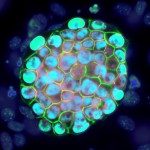Lien vers Pubmed [PMID] – 8898216
Development 1996 Oct;122(10):3023-33
In the mouse, the Kit receptor and its ligand, the stem cell factor (SCF), are encoded at the W/Kit and Steel loci, respectively. The Kit/SCF transduction pathway is involved in promoting cellular migration, proliferation and/or survival of melanoblasts, hematopoietic progenitors and primordial germ cells. Furthermore, a functional Kit/SCF pathway is required for the development of interstitial cells of Cajal (ICC) in the small intestine. Whereas all c-kit-expressing cells in embryogenesis were not identified, previous studies clearly demonstrated that the c-kit expression pattern extends well beyond cells known to be affected by W mutations. To investigate further Kit function, we specifically marked the c-kit-expressing cells and followed their fate during embryogenesis. A mutation was introduced by gene targeting at the W/Kit locus in mouse embryonic stem cells. The lacZ reporter gene was inserted into the first exon of c-kit, thus creating a null allele, called WlacZ. The lacZ expression reflects normal expression of the c-kit gene in WlacZ/+ embryos. The comparison of the patterns of lacZ-expressing cells between WlacZ/+ and WlacZ/WlacZ embryos allowed us to detect where and when melanoblasts, primordial germ cells and hematopoietic progenitors failed to survive in the absence of Kit. We also observed that ICC express c-kit during embryogenesis. ICC are found identically in WlacZ/+ and WlacZ/WlacZ embryos. Therefore, ICC do not depend on Kit expression during embryogenesis. These results indicate that the function of the c-kit gene is only required for the postnatal development of the ICC. Unexpected sites of c-kit expression were uncovered in embryos, including endothelial, epithelial and endocrine cells. None of these cells are dependent on Kit expression for their migration, proliferation and/or survival during embryogenesis. Nevertheless, we assume that the Kit/SCF pathway could be involved in the growth of transformed endothelial, epithelial and endocrine cells.

